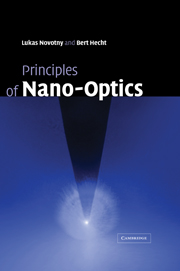Book contents
- Frontmatter
- Contents
- Preface
- 1 Introduction
- 2 Theoretical foundations
- 3 Propagation and focusing of optical fields
- 4 Spatial resolution and position accuracy
- 5 Nanoscale optical microscopy
- 6 Near-field optical probes
- 7 Probe–sample distance control
- 8 Light emission and optical interactions in nanoscale environments
- 9 Quantum emitters
- 10 Dipole emission near planar interfaces
- 11 Photonic crystals and resonators
- 12 Surface plasmons
- 13 Forces in confined fields
- 14 Fluctuation-induced interactions
- 15 Theoretical methods in nano-optics
- Appendix A Semianalytical derivation of the atomic polarizability
- Appendix B Spontaneous emission in the weak coupling regime
- Appendix C Fields of a dipole near a layered substrate
- Appendix D Far-field Green's functions
- Index
2 - Theoretical foundations
Published online by Cambridge University Press: 05 June 2012
- Frontmatter
- Contents
- Preface
- 1 Introduction
- 2 Theoretical foundations
- 3 Propagation and focusing of optical fields
- 4 Spatial resolution and position accuracy
- 5 Nanoscale optical microscopy
- 6 Near-field optical probes
- 7 Probe–sample distance control
- 8 Light emission and optical interactions in nanoscale environments
- 9 Quantum emitters
- 10 Dipole emission near planar interfaces
- 11 Photonic crystals and resonators
- 12 Surface plasmons
- 13 Forces in confined fields
- 14 Fluctuation-induced interactions
- 15 Theoretical methods in nano-optics
- Appendix A Semianalytical derivation of the atomic polarizability
- Appendix B Spontaneous emission in the weak coupling regime
- Appendix C Fields of a dipole near a layered substrate
- Appendix D Far-field Green's functions
- Index
Summary
Light embraces the most fascinating spectrum of electromagnetic radiation. This is mainly due to the fact that the energy of light quanta (photons) lies in the energy range of electronic transitions in matter. This gives us the beauty of color and is the reason why our eyes adapted to sense the optical spectrum.
Light is also fascinating because it manifests itself in the forms of waves and particles. In no other range of the electromagnetic spectrum are we more confronted with the wave–particle duality than in the optical regime. While long wavelength radiation (radiofrequencies, microwaves) is well described by wave theory, short wavelength radiation (X-rays) exhibits mostly particle properties. The two worlds meet in the optical regime.
To describe optical radiation in nano-optics it is mostly sufficient to adopt the wave picture. This allows us to use classical field theory based on Maxwell's equations. Of course, in nano-optics the systems with which the light fields interact are small (single molecules, quantum dots), which necessitates a quantum description of the material properties. Thus, in most cases we can use the framework of semiclassical theory, which combines the classical picture of fields and the quantum picture of matter. However, occasionally, we have to go beyond the semiclassical description. For example the photons emitted by a quantum system can obey non-classical photon statistics in the form of photon-antibunching (no two photons arriving simultaneously).
- Type
- Chapter
- Information
- Principles of Nano-Optics , pp. 13 - 44Publisher: Cambridge University PressPrint publication year: 2006



